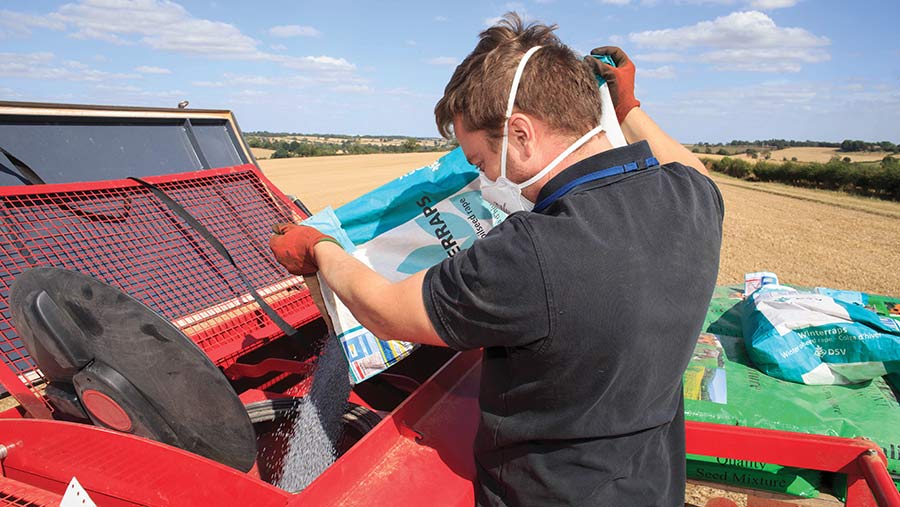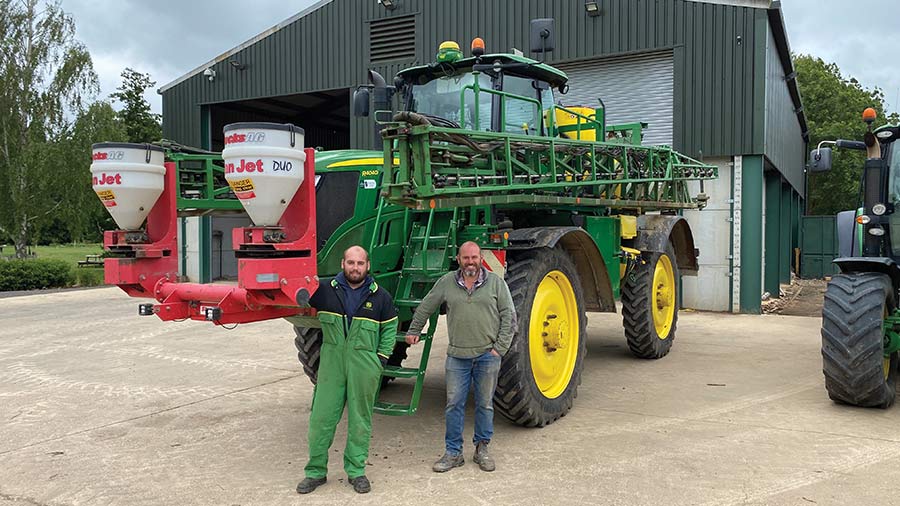Variety blends: Do they work in oilseed rape?
 © Tim Scrivener
© Tim Scrivener Could growing more than one oilseed rape variety in the same field help to lower the crop’s risk and build in some much-needed resilience?
Most farmers have nothing to lose by growing variety blends, suggest crop experts, given the number of negative variables currently affecting the oilseed rape crop and the widespread incidence of patchy and failed fields this year.
In wheat, the practice is used to reduce disease pressure and risk, giving an opportunity to save on inputs in the spring.
See also: How variety blends can protect wheat against septoria
Greater plant diversity seems to work well, with growers often reporting higher yields and lower costs.
So what about oilseed rape? Do the same principles apply or is the crop vulnerable to pressures much earlier on in its life, when the plants are still very small?
Trying out a combination of varieties is a good idea, believes Dick Neale, technical manager at Hutchinsons, who points out that the technique used to be employed when there were more diverse variety lines on the market, some of which were prone to lodging.
“Apart from helping to keep crops standing, there was a case for doing it to get good ground cover, for weed control purposes, as well as derisking the flowering period with some of the earlier hybrids,” he recalls.
Cabbage stem flea beetle
Today, the practice is being used to help take some of the uncertainty out of the establishment period and beyond, he says, but it won’t necessarily limit attack by cabbage stem flea beetle if the pressure is high.
“We do see worthwhile differences between varieties when it comes to cabbage stem flea beetle damage, but we don’t have the same evidence for a variety blend,” he reports.
That is a view shared by Colin Peters, oilseed varieties specialist at Niab, who says growing a blend of varieties doesn’t help with predicting when the adult beetle migration will occur.
“In theory, the beetles will go for the younger, softer plants if you are growing varieties with different speeds of emergence,” he says.
“But I’m not sure that we’ve really seen that happening or tested it out at a field scale.”
Either way, it doesn’t harm yields, and having varieties with opposing early vigour characteristics might reduce the establishment risk, he adds.
“The Aurelia/Aspire mix is a classic combination. Aspire is much slower to emerge – whether it helps or not all depends on when the feeding hits.”
In terms of finding advice on the number of varieties that should be included in a blend, there is very little evidence to support a definitive number.
Much will depend on the area of the crop being grown on the farm, but if three different varieties are available, the consensus seems to be to try them all out in a blend.
Case study: David Miller, Wheatsheaf Farming
Having seen the work Niab has done on wheat variety blends, Hampshire grower David Miller, who is the AHDB’s Strategic Farm South host, was inspired to see if the technique would work as well in oilseed rape.
On the basis that certain varieties get hit harder by pests and diseases than others, he has opted to plant a three-way blend of conventional oilseed rape varieties, consisting of Annika, Campus and Aardvark.

David Miller © Tim Scrivener
Using conventionals will allow him to save the seed if the experiment is a success – something he does across the farm wherever possible to keep costs down. “I don’t grow any hybrids for that reason,” he says.
David describes himself as having a look-see this year.
“The wheat blends in Niab plots were as clean as a whistle. Hopefully, disease levels will be lower in a blend of oilseed rape and pest damage will be reduced.”
He tried this practice once before, but in a different way.
“We grew a tall variety with a shorter one at a low seed rate, with the theory that we would get a better depth of pods.
“But they both competed for light and ended up at the same height, so it wasn’t a success.”
This time, he is more optimistic. “We know that diversity is important in any farming system. Oilseed rape has been grown in the same way for a long time – why not have a look at something different and see what it has to offer?”
Case study: Andrew Melton, Wisbech
AHDB Monitor Farm host Andrew Melton is growing a mix of two oilseed rape varieties – a hybrid and a conventional – across 110ha this year, after achieving success with the technique last year.
His initial interest was sparked by wondering whether it would help the crop withstand flea beetle attack, and he wanted to see if the more vigorous hybrid would grow away from the pest at the expense of the conventional.

Andrew and Sam Melton © AHDB
“That didn’t occur in practice,” he recalls.
“Providing soil moisture was present, the blend established well in both years.”
He adds that the technique is providing more diversity, rather than visibly deterring pests, and that so far there doesn’t seem to be any downsides.
“Thanks to getting the basics right at establishment and with luck on our side, we’ve got some good crops in the ground this year.”
Andrew has various combinations of Attica/Aspire, Duke/Acacia and Duke/Campus growing, which were drilled at a rate of 70 seeds/sq m – evenly split between the two varieties.
Keeping seed costs down
While those varieties wouldn’t necessarily have been his first choices, he was reluctant to commit to a big seed order in such a dry, hot summer.
“That’s why we’ve got various blends across the farm at the moment.”
Last year’s mix was Aspire and Antigua, which he settled on with the help of Limagrain, as the varieties had good disease resistance and similar maturity dates.
Having a conventional variety as half of the mix helps to keep the seed cost down, although he admits to being a fan of hybrids and what they have to offer.
The crop agronomy is carried out just as it would be for a single variety, he explains.
“We use companion crops as standard, which also helps to bring some diversity into the field and provides soil health benefits.”
Having an Adas trial site on the farm allows him to compare the use of blends with single varieties and to see the effect that a companion crop can have.
“There hasn’t been a negative from mixing two varieties, so the likelihood is that we will continue to do so.”

